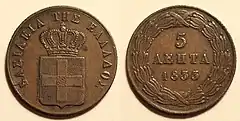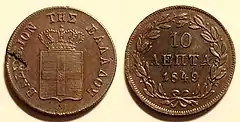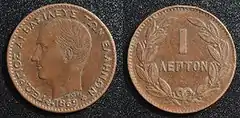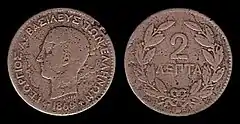The lepton, plural lepta (Greek: λεπτόν, λεπτά), is the name of various fractional units of currency used in the Greek-speaking world from antiquity until today. The word means "small" or "thin", and during Classical and Hellenistic times a lepton was always a small value coin, usually the smallest available denomination of another currency.[1]
The coin in the lesson of the widow's mite (Mark 12:41–44, Luke 21:1–4) is referred to as a lepton and Luke's Gospel also refers to the lepton or mite when stating that a person who does not make peace with his adversary in good time will be required to pay 'to the very last mite' before being released from prison.[2] In the Hasmonean Kingdom the lepton was first minted under Alexander Jannaeus prior to 76 BCE.[3]
In modern Greece, lepton (modern form: lepto, λεπτό) is the name of the 1⁄100 denomination of all the official currencies of the Greek state: the phoenix (1827–1832), the drachma (1832–2001) and the euro (2002–current) – the name is the Greek form of "cent". Its unofficial currency sign is Λ (lambda).[1] Since the late 1870s, and until the introduction of the euro in 2001, no Greek coin had been minted with a denomination lower than 5 lepta.
 20-lepton coin, Phoenician subdivision, 1831.
20-lepton coin, Phoenician subdivision, 1831. 5-lepton coin, drachma subdivision, 1833.
5-lepton coin, drachma subdivision, 1833. 10-lepton coin, drachma subdivision, 1849.
10-lepton coin, drachma subdivision, 1849. One-lepton coin of 1879, the last one-lepton coin of the drachma issued.
One-lepton coin of 1879, the last one-lepton coin of the drachma issued. 2-lepton coin 1869. The last two-lepton coins were minted in 1878.
2-lepton coin 1869. The last two-lepton coins were minted in 1878. An ancient mite of a type still circulating in Jesus' time, typical of what might have appeared in the Bible's lesson of the widow's mite.
An ancient mite of a type still circulating in Jesus' time, typical of what might have appeared in the Bible's lesson of the widow's mite.
References
- 1 2 Fleur de Coin - Greek 50 Lepta Coins
- ↑ Luke 12:59
- ↑ Coins of the Bible Set 2 of 3, Whitman Publishing, LLC, 2004. ISBN 0-7948-1889-7
External links
.jpg.webp)